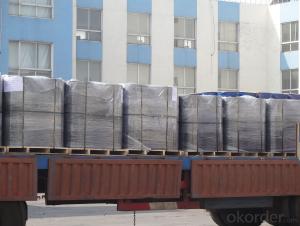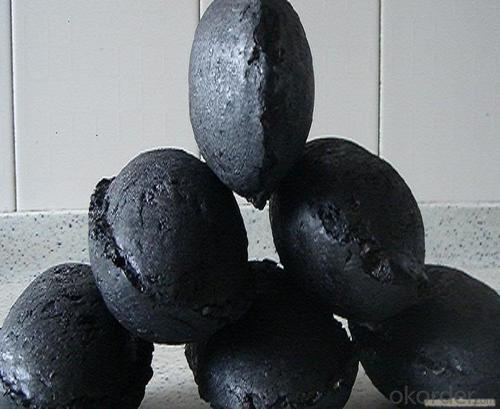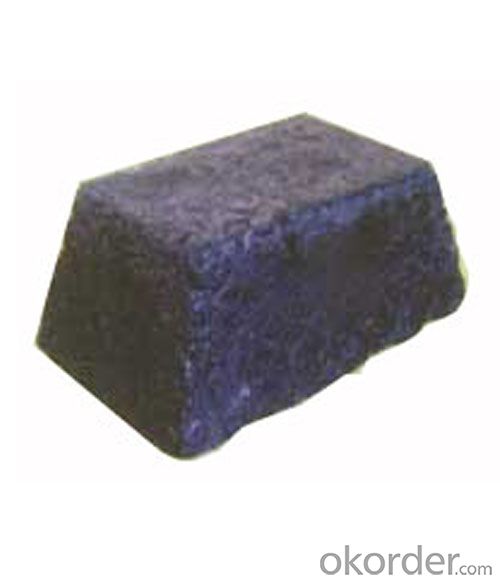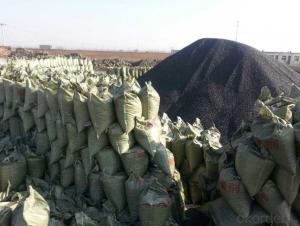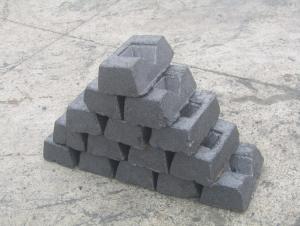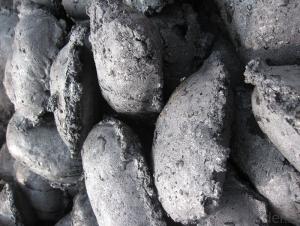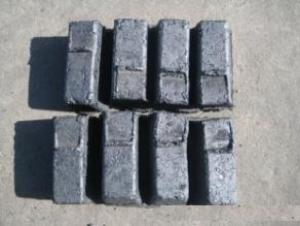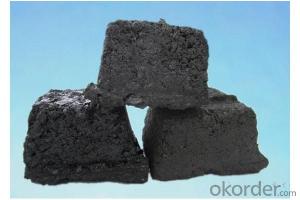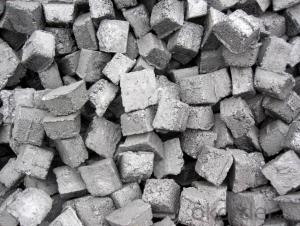Low Ash Carbon Electrode Paste Reasonable Price
- Loading Port:
- Tianjin
- Payment Terms:
- TT OR LC
- Min Order Qty:
- 0 m.t.
- Supply Capability:
- 20000 m.t./month
OKorder Service Pledge
OKorder Financial Service
You Might Also Like
Specifications
Specification/Item |
|
|
|
|
|
|
Ash | 4.0%max | 5.0%max | 6.0%max | 7.0% Max | 9.0% Max | 11.0% Max |
VM | 12.0%-15.5% | 12.0%-15.5% | 12.0%-15.5% | 9.5.0%-13.5% | 11.5%-15.5% | 11.5%-15.5% |
Compress Strength | 18.0Mpa Min | 17.0Mpa Min | 15.7Mpa Min | 19.6Mpa Min | 19.6Mpa Min | 19.6Mpa Min |
Specific Resistance | 65μΩm Max | 68μΩm Max | 75μΩm Max | 80μΩm Max | 90μΩm Max | 90μΩm Max |
Bulk Density | 1.38G/CM3 Min | 1.38G/CM3 Min | 1.38G/CM3 Min | 1.38G/CM3 Min | 1.38G/CM3 Min | 1.38G/CM3 Min |
Main Function And Features
1) Low ash content
2) Good electric and thermal conductivity
3) High resistance to temperature
4) Stable quality
5) Reasonable price
6) Size:all kinds of electrode paste
7) Accord customer's reques change
Introduction To Products
1) Carbon Electrode Paste is a self-baking electrode used in submerged arc furnaces for delivering power to the charge mix.
2) Electrode Paste is added to the top of the electrode column in either cylindrical or briquette form.
3) As the paste moves down the electrode column the temperature increase causes the paste to melt and subsequently bake
forming a block of electrically conductive carbon.
4) Electrode Paste is essentially a mix of Electrically Calcined Anthracite (ECA) or Calcined Petroleum Coke (CPC) with Coal
Tar Pitch.
Application Range
1) Be used as the electrode for self roasting in the iron-alloy furnace and acetylene furnace.
2) Amorphous graphite powder--applied in steel making,fireproof material,casting coating.
3) Calcined petroleum coke--used in foundry,metallurgy,carbon paste,graphite electrode.
4) Carbon anode scrap--used as smelting fuel for copper smelting industry.
5) Carbon electrode paste--applied in iron alloy,calcium carbide,ferroalloy,ferromanganese.
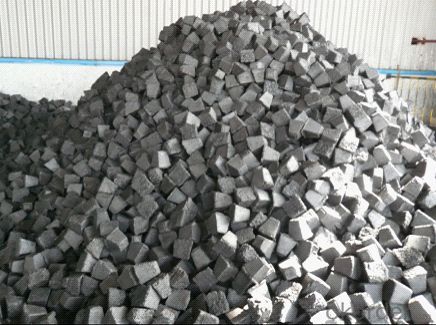
- Q: What are the impacts of carbon emissions on the stability of wetlands?
- Carbon emissions have significant impacts on the stability of wetlands. Increased levels of carbon dioxide in the atmosphere contribute to climate change, resulting in rising temperatures and changes in precipitation patterns. These changes can lead to the degradation and loss of wetlands, as they are sensitive ecosystems that rely on specific hydrological conditions. Additionally, carbon emissions contribute to ocean acidification, which can affect the health of coastal wetlands that depend on a delicate balance of saltwater and freshwater. Overall, carbon emissions pose a threat to the stability and long-term survival of wetlands, with far-reaching ecological and socioeconomic consequences.
- Q: How does carbon impact the prevalence of tsunamis?
- The prevalence of tsunamis is not directly impacted by carbon dioxide. Tsunamis primarily occur due to undersea earthquakes, volcanic eruptions, or underwater landslides. These events release massive amounts of energy into the water, creating powerful waves that can travel across the ocean and cause devastating destruction upon reaching the coast. Although tsunamis are not directly caused by carbon dioxide emissions, there is a connection to climate change, which can indirectly influence the frequency and impact of these natural disasters. The increased levels of carbon dioxide and other greenhouse gases in the atmosphere contribute to global warming, resulting in the rise of sea levels. As the sea levels rise, coastal areas become more susceptible to the destructive force of tsunamis, as the waves can penetrate further inland. Additionally, climate change can also have an impact on the frequency and intensity of extreme weather events like hurricanes and tropical storms. These weather patterns can trigger underwater landslides or increase the likelihood of volcanic eruptions, both of which can lead to the occurrence of tsunamis. In conclusion, while carbon dioxide emissions do not directly cause tsunamis, they do play a role within the broader context of climate change. This indirect impact can result in rising sea levels and the potential for more frequent extreme weather events, ultimately affecting the prevalence and impact of tsunamis.
- Q: What is the carbon content of different types of soil?
- The carbon content of different types of soil can vary significantly depending on various factors such as climate, vegetation, and land management practices. Generally, soils with higher organic matter content tend to have higher carbon content. Peat soils, for example, have the highest carbon content among all soil types, ranging from 30% to 60%. These soils are formed in wetland areas where the decomposition of organic matter is slow due to water saturation. As a result, large amounts of carbon accumulate over time. Forest soils also tend to have relatively high carbon content, varying between 1% and 10%. Forests provide a continuous supply of organic matter through litterfall, which contributes to the build-up of carbon in the soil. Agricultural soils, on the other hand, typically have lower carbon content compared to peat or forest soils. The carbon content of agricultural soils is influenced by factors such as crop rotation, organic amendments, and tillage practices. Depending on these factors, carbon content in agricultural soils can range from less than 1% to around 6%. Grassland soils may have carbon contents similar to agricultural soils, depending on the management practices. However, in undisturbed grasslands with high plant productivity, carbon content can be relatively higher, ranging from 2% to 8%. In arid and desert regions, soils tend to have lower carbon content due to limited vegetation and slower organic matter decomposition rates. Carbon content in these soils is often less than 1%. It is important to note that these ranges are generalizations, and the carbon content of soil can vary within and between soil types. Additionally, changes in land use, such as deforestation or conversion of grasslands to agriculture, can significantly impact the carbon content of soils.
- Q: What are the impacts of carbon emissions on biodiversity?
- Biodiversity is significantly affected by carbon emissions, which have various consequences. One of the primary outcomes is climate change, which results from the release of greenhouse gases, including carbon dioxide, into the atmosphere. As the Earth's temperature increases, it disrupts the delicate balance of ecosystems, causing the loss of biodiversity. Habitat loss is a major effect of climate change on biodiversity. Many species are adapted to specific environmental conditions, and as these conditions change, their habitats become unsuitable. This can lead to the extinction of species that cannot adapt or migrate to new areas. For instance, coral reefs are highly sensitive to temperature changes, and with the ocean warming due to carbon emissions, numerous coral species are at risk of bleaching and dying off. Carbon emissions also disrupt ecological interactions, which are crucial for the survival of many species. Numerous species rely on specific relationships with other species, such as pollination or predation. Climate change can alter the timing of these interactions, potentially causing mismatches between species. For example, if flowering plants bloom earlier in the year due to warmer temperatures, but their pollinators are not yet active, it can result in reduced pollination and reproductive success. Furthermore, carbon emissions contribute to ocean acidification, which occurs when seawater absorbs carbon dioxide, leading to a decrease in pH. This acidification negatively affects marine organisms, especially those with calcium carbonate shells or skeletons, like corals, mollusks, and some plankton. The increased acidity makes it challenging for these organisms to build and maintain their protective structures, potentially causing population declines and disruptions in ecosystems. In general, the impacts of carbon emissions on biodiversity are extensive and profound. They not only threaten individual species but also disturb entire ecosystems and their functioning. To mitigate these effects, it is essential to reduce carbon emissions and transition to cleaner and more sustainable energy sources. Additionally, conserving and restoring habitats, implementing effective conservation strategies, and promoting sustainable land and water management practices can help protect and restore biodiversity in the face of climate change.
- Q: How does carbon impact the prevalence of avalanches?
- The prevalence of avalanches is greatly influenced by carbon. The rise in carbon emissions and subsequent global warming results in alterations to the stability of snowpack, ultimately impacting the frequency and severity of avalanches. As temperatures increase, snowfall patterns become more uncertain, characterized by more frequent freeze-thaw cycles. This causes the snowpack to weaken, as the snow loses its cohesion and becomes more prone to sliding. Moreover, higher temperatures lead to a greater amount of rainfall instead of snow, further destabilizing the snowpack by adding weight and reducing its strength. These changes in snowpack stability heighten the probability of avalanches occurring. Additionally, climate change also modifies the timing and duration of snow accumulation. Warmer temperatures result in earlier snow melt, which can result in a diminished snowpack during the peak avalanche season. This, in turn, increases the likelihood of triggering avalanches as there is a smaller amount of stable snow to support the added weight and stress from additional snowfall or human activity. Furthermore, carbon-induced climate change has the ability to affect the frequency and intensity of extreme weather events, such as heavy snowfalls or rainstorms. These events can cause rapid and significant alterations to snowpack conditions, ultimately leading to an elevated risk of avalanches. In conclusion, the impact of carbon on the prevalence of avalanches is substantial. The warming climate affects snowpack stability, the timing and duration of snow accumulation, and the frequency of extreme weather events, all of which contribute to an increased risk and prevalence of avalanches.
- Q: What's the difference between coal and carbon?
- Coke, too, is quite different from coal in physical properties.
- Q: What is carbon nanowire?
- Carbon nanowires are one-dimensional structures made entirely of carbon atoms. They are incredibly thin, with diameters ranging from a few nanometers to a few micrometers, while their length can vary from a few micrometers to several centimeters. These nanowires possess exceptional electrical, thermal, and mechanical properties due to their unique structure and composition. Carbon nanowires can be produced through various methods, such as chemical vapor deposition, electrospinning, or template synthesis. They can have different structures, including single-walled or multi-walled, and can be straight or coiled. The properties of carbon nanowires can be further enhanced by incorporating other elements or functional groups into their structure. One of the most significant advantages of carbon nanowires is their high electrical conductivity, which makes them suitable for various electronic and energy applications. They can be used as interconnects in nanoscale devices, electrodes in energy storage devices like batteries and supercapacitors, and in sensors for detecting various substances due to their exceptional sensitivity. Carbon nanowires also exhibit exceptional mechanical properties, such as high tensile strength and flexibility. These properties make them suitable for applications in nanotechnology, including reinforcement in composite materials, nanoscale actuators, or as templates for fabricating other nanoscale structures. Furthermore, carbon nanowires possess excellent thermal conductivity, which makes them potential candidates for thermal management applications, such as heat sinks or as fillers in thermal interface materials. In summary, carbon nanowires are ultrathin carbon-based structures with remarkable electrical, thermal, and mechanical properties. Their unique characteristics make them promising materials for a wide range of applications in electronics, energy, sensing, nanotechnology, and thermal management.
- Q: How does carbon dioxide affect the Earth's climate?
- The Earth's climate is significantly affected by carbon dioxide (CO2), a greenhouse gas. When released into the atmosphere through natural and human activities like deforestation, burning fossil fuels, and industrial processes, carbon dioxide traps heat from the sun and prevents it from escaping into space. This process is commonly referred to as the greenhouse effect. The accumulation of carbon dioxide in the atmosphere leads to a rise in global temperatures, resulting in climate change. As CO2 levels increase, more heat gets trapped, causing the Earth's average temperature to rise over time. This phenomenon is known as global warming. The consequences of increased carbon dioxide levels and subsequent climate change are extensive. Rising temperatures cause glaciers and polar ice caps to melt, contributing to a rise in sea levels. This can lead to coastal flooding, displacement of communities, and loss of biodiversity. Moreover, altered weather patterns, including more frequent and intense heatwaves, droughts, and extreme weather events like hurricanes and storms, are also associated with increased carbon dioxide levels. These events can have devastating impacts on ecosystems, agriculture, and human settlements. Furthermore, elevated CO2 levels also impact the chemistry of the oceans, making them more acidic through a process called ocean acidification. This poses a threat to marine life, especially organisms with calcium carbonate shells, such as corals and shellfish. To mitigate the impacts of carbon dioxide on the Earth's climate, it is crucial to reduce greenhouse gas emissions. This can be accomplished by transitioning to renewable energy sources, improving energy efficiency, promoting sustainable land use practices, and adopting cleaner technologies. Additionally, initiatives like afforestation and reforestation can help absorb CO2 from the atmosphere, acting as carbon sinks. Taking action to address the issue of carbon dioxide and its impact on the Earth's climate is vital to protect the planet's ecosystems, biodiversity, and human societies. By reducing carbon emissions, we can lessen the effects of climate change and work towards a more sustainable future.
- Q: How can we reduce carbon emissions from transportation?
- We can reduce carbon emissions from transportation by promoting the use of electric vehicles, improving public transportation infrastructure, encouraging carpooling and cycling, implementing stricter fuel efficiency standards, and investing in renewable energy sources for vehicles. Additionally, adopting more sustainable transportation policies and practices, such as telecommuting and promoting walkable communities, can significantly contribute to reducing carbon emissions.
- Q: What are the properties of carbon-based lubricants?
- Carbon-based lubricants have several important properties. Firstly, they have a low friction coefficient, which means they reduce friction between moving parts, thereby minimizing wear and tear. Additionally, carbon-based lubricants have excellent thermal stability, allowing them to perform effectively even at high temperatures. They also exhibit good chemical stability, resisting degradation and maintaining their lubricating properties over time. Furthermore, carbon-based lubricants are typically non-toxic and environmentally friendly, making them a preferred choice in many applications.
Send your message to us
Low Ash Carbon Electrode Paste Reasonable Price
- Loading Port:
- Tianjin
- Payment Terms:
- TT OR LC
- Min Order Qty:
- 0 m.t.
- Supply Capability:
- 20000 m.t./month
OKorder Service Pledge
OKorder Financial Service
Similar products
Hot products
Hot Searches
